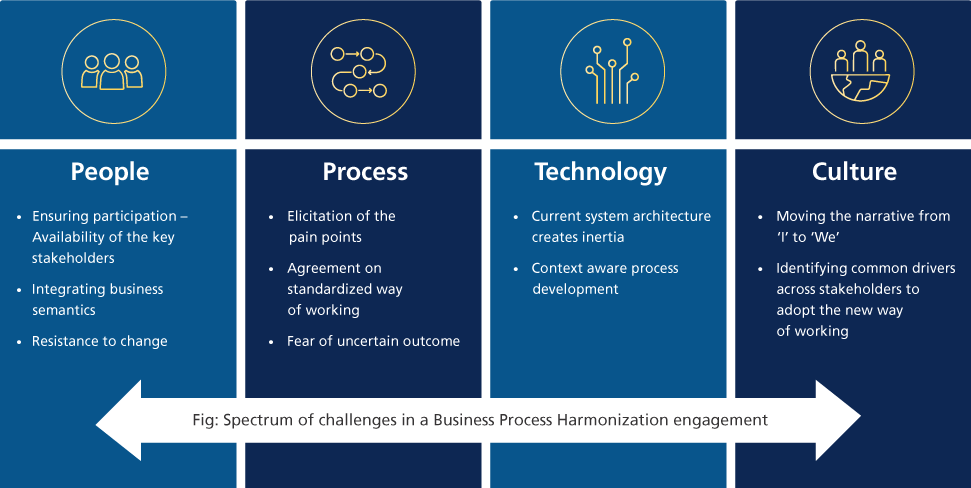Applying Design Thinking to Business Process Harmonization: A Consultant’s perspective
Complex market conditions combined with digitally empowered consumers present a challenging environment for businesses to operate in. Most business leaders understand that innovation and agility are the answers, but the question is how they can be achieved. Creating a next generation enterprise suited to this new ‘digital normal’ is about understanding and managing processes that combine the people and technology pieces of the puzzle. When processes are documented, aligned, and applied as standard practices, achieving organizational efficiencies becomes effortless. People can then contribute to innovation and drive improvements in a more empowered way.
In the context of complex transformation projects, businesses require adaptability for implementing new processes. The vastly different business outcomes during the recent COVID-19 pandemic bear ample testimony to this need for adaptability. Companies that were able to pivot quickly to remote work had higher success rates of maintaining business operations and had this flexibility ingrained in their processes. However, other businesses that crumbled could not adapt to change, even if they were able to sense the implications.
Both industry experts and academic researchers have written a lot about the importance of standardization and harmonization in achieving this alignment and efficiency of business processes across multiple departments or business units (BUs) of large enterprises. The consistent highlight remains the human dimension of process understanding as being the key challenge. In my experience, applying design thinking principles to business process harmonization (BPH) can have a dramatic impact on socializing, documenting, aligning and improving business processes, leading to higher success rates in such engagements.
Challenges in Business Process Harmonization
Business process harmonization (BPH) requires an investment of time, money, and resources. However, it is a critical component of a large digital transformation project. Such projects flourish when BPH blends common processes with technological innovation, ultimately catering to the needs of the customer and their end customers.
By taking the time to discover processes and define new processes which are both efficient and customer-centric, the project can be setup for long-term success. However, such projects that require BPH typically face challenges related to people, process, technology and organization culture.

Applying Design Thinking to Business Process Harmonization
A design thinking-led consulting approach towards business process harmonization focuses on working through three different lenses: business vision, design, and technology. Therefore, a team of consultants requires designers, business consultants, and technology specialists to join forces to conquer the challenges that arise. Each team member brings a different perspective and set of skills that can help understand and phrase the problem and shape the solution.

A Design Thinking Approach towards Business Process Harmonzation
The approach consists of 3 phases:
- Studying the ‘As-Is’ landscape – Here, the idea is to engage with clients in a workshop mode wherein the ‘As-Is’ processes are explained per business process area by existing process owners or BU leads. Also, questionnaires customized towards the business context are populated through collaboration to record certain critical aspects across the business process spectrum in scope of the engagement. Any collaterals available with the client are shared and studied by the team of consultants. The outcome is developing a deep understanding of the needs from the user perspective across different business units (BUs).
- Formulating the ‘To-Be’ state – Here, the team of consultants starts with a blank canvas approach to define the target state of the client’s business landscape across at least three workstreams:
- Common process definitions and standards across BUs
- Homogenous user experience across BUs
- Common tool features and harmonized technology architecture
- Refine the ‘Target’ state – Here, the team of consultants engages with clients through a workshop mode to test, adapt, and improve the synthesized ‘To-Be’ state in step 2. This helps to uncover the following aspects early in the journey:
- Core process definitions and BU specific exceptions
- Architectural (technology) considerations including features, functionalities and integration needs
- User training and change management considerations
Using a design thinking-led approach for process discovery, assessment, and harmonization, helps to achieve better outcomes as the methodology relies on observing, listening, and adapting to the client’s needs at the core of the overall engagement effort. Through a constant dialogue, this approach reaps indirect benefits by spreading awareness across different departments and teams in the client organization – socializing the need of process harmonization to create a unified operational entity. It creates buy-in at each stage of evolution towards the target state, which leads to higher success rates. And, not to forget that it’s all about ‘Being Agile’ throughout the engagement – focused more on the journey than the outcome!
At LTIMindtree, we are well-equipped to drive successful business transformations that leverage BPH. Due to our vast client experience, we know what works and what doesn’t work in the business process and experience transformation space, and from a technical perspective where the areas of opportunities and potential blocks exist. With our expertise in strategic advisory, technology and data consulting, AI and automation, and ESG and organizational change and transformation, we help organizations achieve their desired benefits leading to a truly transformed future.
Checkout our consulting services overview. Let’s get to the future, faster. Together!
More from Tushar Sehjpal
‘Language Models (LMs)’ in the field of Natural Language Processing (NLP) are not new.…
According to a 2023 Gartner report1, more than 80% of enterprises will have incorporated generative…
We stand at a juncture in the evolution of the internet where the next big step towards the…
Latest Blogs
Core banking platforms like Temenos Transact, FIS® Systematics, Fiserv DNA, Thought Machine,…
We are at a turning point for healthcare. The complexity of healthcare systems, strict regulations,…
Clinical trials evaluate the efficacy and safety of a new drug before it comes into the market.…
Introduction In the upstream oil and gas industry, drilling each well is a high-cost, high-risk…




